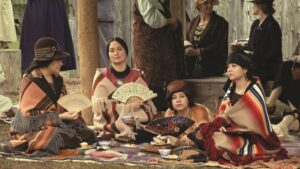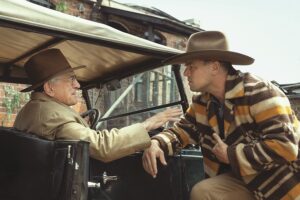Throughout his illustrious career, filmmaker Martin Scorsese has been obsessed with the powerful pull of family, culture, and faith. Their power can be frustrating and repressive — leading to explosions of violence and depravity — and it can inspire a sense of awe and shame. Scorsese, who grew up in New York’s Little Italy as a small, asthmatic kid among the former ghetto’s petty hoodlums, has explored those themes within the Italian-American community that he knows so intimately (Mean Streets, Raging Bull, Goodfellas, and Casino) and also far and wide, from the ancient Holy Land (The Last Temptation of Christ), to Tibet as the setting for the Dalai Lama (Kundun), to the late-20th-century go-go heyday of New York high finance (The Wolf of Wall Street).
In adapting David Grann’s 2017 nonfiction bestseller, Killers of the Flower Moon: The Osage Murders and the Birth of the F.B.I., he delves into Oklahoma in the early 1920s, where members of the Osage tribe have discovered oil on their land and become prey for the genocidal whites who had sequestered them on a reservation. Oklahoma was known as “Indian Territory” before becoming a state and was considered a wasteland before mineral rights made it desirable. The murders of Osage people during this period are estimated to number in the hundreds, and it became known as a “reign of terror.”

Whereas Grann’s book focuses on the F.B.I.’s investigation of the Osage murders, the centerpiece of the film is a tragic romance, one that feels like the stuff of ancient Greek drama with a paradoxical combination of heartfelt devotion and murderous betrayal.
Some viewers have had qualms about the movie because a story that should be owned by its Native American victims is being told by an outsider. But Scorsese imbues the picture with a profound respect for the Osage, including their language, culture, and spiritual beliefs — all of which they retain despite a conversion to Christianity and a pragmatic adherence to the laws and norms of European American civilization, so often imposed on indigenous people.
There is still room, of course, for a fully indigenous interpretation of this sordid piece of American history, but given that Scorsese focuses on the sins of white people and the tragedy of the Osage are Scorsese’s focus as an artist — and not on the federal authorities as saviors — Killers of the Flower Moon may be as true and worthy a film as it could be, considering its authorship.
It begins with the arrival of Ernest Burkhart in Fairfax, Okla. This 24-year-old veteran of World War I is played by 48-year-old Leonardo DiCaprio with a mouth turned down in a permanent scowl, a mask that ultimately belies his extreme emotional dissonance. Burkhart is seeking his uncle, the rancher William Hale, a wizened old man who pretends to be an avid supporter of his Osage neighbors but is actually the principal architect of a plan to kill off those with oil rights and steal their wealth.

Hale is played by Robert De Niro with a scowl similar to DiCaprio’s, but they are not equals: the old man is a sly schemer, unshakable in his racism, while Burkhart is just a tool. Though the younger man helps to execute his uncle’s merciless plan with cowardly resolve, he makes the mistake of falling in love with its prime target: Mollie Kyle, a sharp-witted and educated Osage woman, played with extraordinary gravitas and quiet charm by Lily Gladstone. Mollie’s family owns a fortune in oil rights, and despite her wariness of the local whites, she falls for Ernest and marries him, and they have two children.
One by one, all of Mollie’s sisters, potential heirs, and witnesses are poisoned, shot in cold blood, or killed by bombs. The acts of terrorism besiege the community, and they go largely uninvestigated and unpunished by local authorities. The intervention of federal agents finally does help (J. Edgar Hoover led the nascent F.B.I.’s first big P.R. success), but it is too little, too late. A lasting trauma has already been inflicted. The message is clear: even when you score playing the white man’s game, if you’re Osage, you still lose.
Scorsese couches this epic real-life saga in a faux newsreel of the Osage murders and the Tulsa “race riots” (the latter actually a pogrom inflicted by whites on successful Black businesses) and with a radio play celebrating the role of G-men. It’s a form of self-critique: even those who have told this story have often been corrupt — it’s a cautionary tale, not a heroic one, and shouldn’t be exploited.
Indeed, Scorsese tones down his usual operatic shooting style for this movie, which most resembles Kundun in its reverence, and the late Robbie Robertson’s plaintive score eschews any rock music. He still uses expressive angles and poetic imagery, as is his wont, but they’re understated and elegiac. This is consistent through the last shot, an overhead view, pulling back, of a circle of mourning Osage. I was reminded of the final line in the “appendix” to William Faulkner’s The Sound and the Fury, in which the author says of the Black servants of a diminished Southern family: “They endured.”
